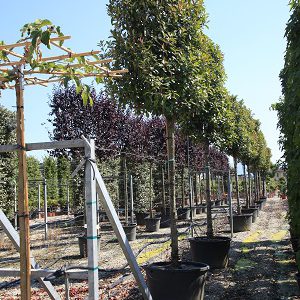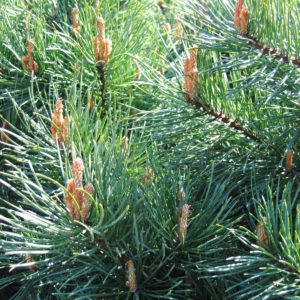Pinus strobus
€480.00
Frequently Bought Together


Description
Quick Facts
- Common Name: Eastern White Pine, White Pine, Weymouth Pine
- Botanical Name: Pinus strobus
- Plant Type: Evergreen conifer tree
- Mature Height: 20-30m
- Mature Spread: 6-10m
- Flowering Period: May to June (cones)
- Flower Colour: Yellow male cones, green female cones
- Foliage: Soft blue-green needles in bundles of five, graceful and feathery
- Hardiness: RHS H7 (very hardy)
- Soil Requirements: Moist, well-drained, acidic to neutral
- Aspect: Full sun to partial shade
- Maintenance: Low
Description
Experience the graceful beauty of Pinus strobus, the magnificent Eastern White Pine that brings exceptional elegance, soft texture, and commanding presence to large gardens with its distinctive blue-green needles and refined character. This outstanding evergreen conifer offers remarkable qualities—soft flexible needles measuring 6-12cm long arranged in bundles of five in beautiful blue-green to grey-green creating delicate feathery texture unlike the stiff appearance of many pines, elegant pyramidal to columnar form with horizontal branching creating graceful layered structure and architectural presence, attractive long slender cones measuring 10-20cm that dangle gracefully from branches adding ornamental interest, and fast growth rate combined with exceptional hardiness making this one of the most adaptable and elegant large pines for creating year-round structure, screening, and timeless beauty in gardens.
Throughout the year, this captivating tree displays its characteristic soft flexible needles measuring 6-12cm long arranged in distinctive bundles of five (a key identification feature) in beautiful blue-green to grey-green with fine white lines creating a soft, feathery appearance. The needles are remarkably soft to touch—unlike the stiff prickly needles of many pines, these are gentle and flexible, making this one of the most tactile and child-friendly conifers. The overall effect is elegant and refined rather than harsh. The foliage is held on smooth greenish-grey branches that become increasingly fissured and darker with age. In late spring to early summer (May-June), the tree produces small yellow male cones that release clouds of pollen alongside green female cones near branch tips. The female cones develop into the tree’s most distinctive feature—long slender cylindrical cones measuring 10-20cm long that dangle gracefully from the branches. The cones are green when young, ripening to light brown, and often curve slightly, creating elegant ornamental interest. The cones open to release winged seeds and persist on the tree. The bark on young trees is smooth and greenish-grey, developing into attractive deeply furrowed dark grey-brown bark with broad ridges on mature trees. The elegant pyramidal to columnar form with horizontal branching creates graceful layered structure—more refined than many pines.
Native to eastern North America from Newfoundland to Georgia, Pinus strobus was introduced to Britain in 1705 by Lord Weymouth (hence the alternative name Weymouth Pine) and became widely planted. The species name ‘strobus’ is the ancient Latin name for this tree. This was historically one of the most important timber trees in North America—tall, straight trunks were prized for ship masts. Exceptionally hardy and adaptable, this pine thrives in temperate climates, tolerating cold winters, exposure, and urban pollution. Prefers acidic to neutral soil and consistent moisture but adapts to various conditions. Fast-growing, establishing quickly and providing substantial screening and structure within 10-15 years—faster than many large conifers. Long-lived (200-400 years in ideal conditions). The substantial size makes this suitable for large gardens, estates, and parklands with ample space.
Create stunning compositions by planting as spectacular specimen trees in large gardens, estates, or parklands where the elegant form, soft blue-green foliage, and graceful structure can be fully appreciated. Exceptional as screening and windbreak plantings where the fast growth and dense foliage create effective shelter—plant in groups or rows for enhanced impact. Works beautifully in woodland gardens, naturalistic landscapes, or as commanding focal points where the refined texture and architectural presence create year-round interest. The soft needles and elegant cones make this ideal for positions near pathways or seating areas where the tactile qualities can be enjoyed. NOT suitable for small or medium gardens—this is a large, fast-growing tree that needs substantial space. Perfect for large properties seeking elegant screening, year-round structure, and graceful beauty.
Caragh Garden Notebook
Planting: Space trees 8-10m apart for screening or windbreak plantings, or allow 12-15m for specimen placement to accommodate the mature spread—this tree needs significant space. Plant container-grown specimens year-round, though autumn or early spring is ideal. Dig holes twice the width of the root ball and incorporate organic matter. Plant at the same depth as the container. Stake for the first 3-5 years. Water thoroughly and mulch around the base with acidic mulch (pine bark, composted pine needles). Choose positions in full sun to partial shade—full sun produces best growth and foliage colour. Not suitable for small or medium gardens due to large size and fast growth.
Soil Preparation: Thrives in moist, well-drained soil with pH 4.5-6.5. Prefers acidic to neutral conditions—dislikes alkaline or chalky soils which can cause chlorosis (yellowing needles) and poor growth. Requires deep, moisture-retentive, fertile conditions enriched with organic matter. Tolerates sandy and loamy soils. Dislikes waterlogged, compacted, or very dry soils. Dislikes salt spray and coastal exposure—not suitable for exposed coastal gardens. Best growth occurs in full sun to partial shade with well-drained, acidic soil, consistent moisture, and shelter from harsh winds and salt spray.
Container Growing: Not suitable for container growing due to very large size, fast growth, extensive root system, and need for space to develop the characteristic elegant pyramidal form and graceful layered branching. This is a tree for planting in the ground in large gardens, estates, or parklands where it can reach its full magnificent potential and provide the elegant screening, year-round structure, and commanding presence over many decades.
Seasonal Care: Requires minimal pruning—the naturally elegant pyramidal form develops without intervention and should be preserved. Remove only dead or damaged branches as needed. If formative pruning is required, do so in late winter when young to establish a strong central leader and well-spaced whorls of branches. Avoid heavy pruning as pines do not regenerate from old wood—cuts into bare wood will not produce new growth. Apply slow-release balanced or ericaceous fertiliser in early spring if desired. Mulch annually with acidic organic matter (pine bark, composted pine needles). Water during dry spells in the first 5-7 years until established—consistent moisture improves growth. Watch for white pine blister rust (a fungal disease requiring alternate host plants—remove any nearby Ribes species) and white pine weevil (attacks terminal shoots—remove and destroy affected shoots). Generally trouble-free in suitable conditions.
Propagation: Can be grown from seed collected from ripe cones in autumn, though seedlings take many years to reach substantial size. Seeds require cold stratification over winter. Sow in autumn or spring in pots using ericaceous compost—germination occurs in spring and can be erratic. Seedlings grow relatively quickly once established compared to many conifers. Selected cultivars (such as ‘Pendula’, ‘Radiata’, ‘Fastigiata’) are propagated by grafting onto P. strobus rootstock. Home gardeners seeking screening or specimen trees within reasonable timeframes should purchase nursery-grown trees of good size.
This elegant beauty is absolutely magnificent—one of the most graceful and refined large pines available! Those soft flexible blue-green needles in bundles of five create such delicate feathery texture—so tactile and gentle, unlike stiff prickly pines. The long slender cones dangling gracefully are beautiful, the elegant pyramidal form with layered branching is refined, and that fast growth provides screening quickly. Exceptionally hardy, long-lived, and more elegant than most pines. Remember acidic soil is essential—dislikes chalk and coastal salt spray. CRITICAL: needs substantial space—this is a large fast-growing tree for estates and parklands. Perfect for elegant screening, year-round structure, and graceful architectural presence. Timeless refined beauty!





